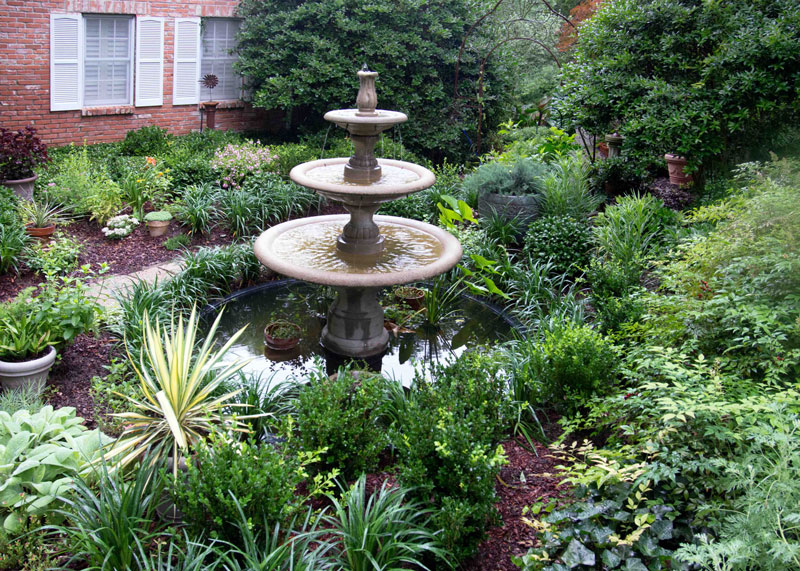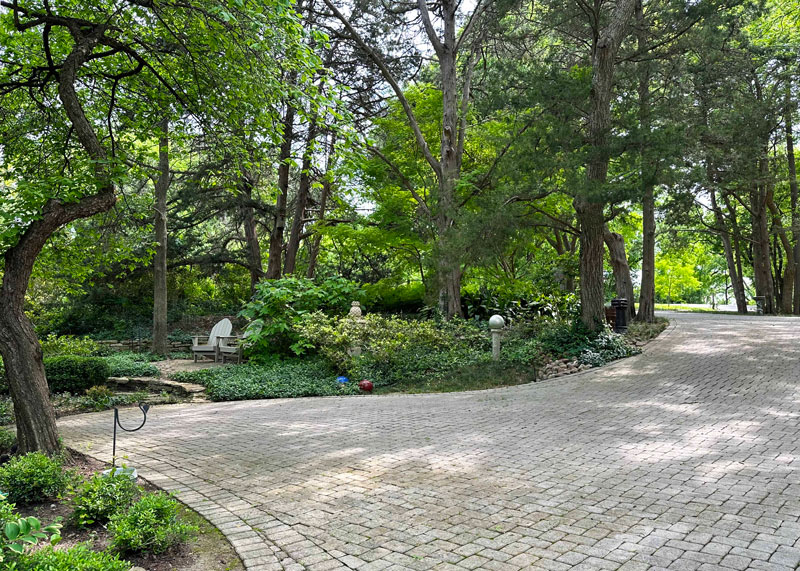Q&A – Ask Neil: August 15, 2024
(Please read these instructions carefully.)
Before you post your question, please look at recent issues to see if someone else has already asked it. You might find your answer there.
How to submit your question…
(Note: You may need to allow a pop-up window to come up in order to get the link for sending your photo(s). If you have already submitted your question and didn’t see the pop-up window, please click here.)
• Click the link provided below to post your question. After you submit your question, a new window will pop up giving you the address to which you can e-mail a SHARP, HIGH-RESOLUTION PHOTO to accompany your question. Please DO NOT SEND THUMBNAIL PHOTOS in case I need to zoom in to see things.
• Click here to post your question.
• Please ONLY POST YOUR QUESTION ONE TIME. We can only accept a set number of questions each week, and when we get duplicates it costs other people their chances.
• One question per reader, please.
• Please use this only for posting questions – not for standard emails.
• Watch for your answer in the following week’s e-gardens.
• I choose those of greatest general interest. For example, plant IDs seldom make the cut.
• I must have your first name or initials.
• I must have your city or county. (Texas is a very large state.)
QUESTION 1
WHAT SUGGESTIONS FOR A MID-19th CENTURY LOOK AROUND THIS HISTORICAL CABIN?
Question: The Wise County Historical Society owns the Harding-Gregg cabin. We aim to create a flowering landscape around the cabin to recreate a mid-19th Century look. I have planted Salvia greggii and Gregg’s mistflower. Suggestions?
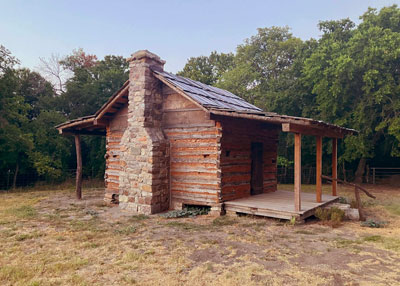
Answer: What a fun project. It’s one that should have hours/days/months of planning before any major planting commences. Start with research of what plants were used in Wise County at that time. You won’t be able to include all of them, nor would you want to – it would be too much to maintain. In fact, that’s where you really need to start. Who will be responsible for watering and weeding? Without those provided, you’re wasting your time. And keep the beds simple. No elaborate edgings and no fancy mulches other than compost. Nothing that wouldn’t have existed 170 years ago.
I’d suggest you take a few weekends to make excursions to other similar ventures in other cities. Master Gardeners Associations in the various regions will be familiar with what has been done in their areas. Nurseries that cater to heirloom plants could be a great help. Visit the Antique Rose Emporium in Independence, Blue Moon Gardens east of Edom toward Tyler, and others of a similar nature. Vertigo has kept me from traveling as much as I’d like for the past 8 years, but there are some wonderful examples around Texas. They’d be flattered to share their ideas with you. Stay completely away from plants that didn’t come into the market until after that era.
Your two plants are great. Beyond them…
Develop a list of the annuals that would have been grown in Wise County. They’ll be heirloom types that are probably surviving in older neighborhoods of Decatur and other legacy towns of Wise County. Reseeding petunias and larkspurs are classic examples. You’ll find many more.
The list of perennials will be extensive. Some will be native to Texas, and some will be plants settlers would have brought with them from other parts of America and the world. Daffodils and jonquils. (Much as I hate to break my own rule, I might suggest the variety Carlton. It’s only 100 years old, but it’s a great naturalizer and it looks right at home.), White flag iris and the old single orange daylily Hemerocallis fulva. Orange hardy lantana Lantana urticoides. Purple coneflowers, rock rose (Pavonias), gayfeathers (Liatris), Texas star hibiscus, Turkscap (Malvaviscus arboreus var. drummondii), and flame honeysuckle (Anisacanthus wrightii).
It wouldn’t be an old-fashioned Texas garden without a red flowering quince, a single-flowering lavender rose-of-Sharon, and a redbud.
That’s my starter list off the top of my head, no web browsing or book searching involved. If one of your members takes a keen interest, forms a small committee, and spends a few months in doing the homework, this could be charming. Just remember the water and maintenance.
QUESTION 2
SHOULD I BE CONCERNED ABOUT THIS CRACK IN THE BARK OF MY PECAN?
Question: I found this crack in the bark of our pecan tree’s trunk recently. The tree was planted in 2020 by my uncle from a pecan. The crack in 8 in. top and bottom and 3 ft. off the ground. The tree’s circumference is 9 in. How concerned should I be? Dennis R., Navarro County.
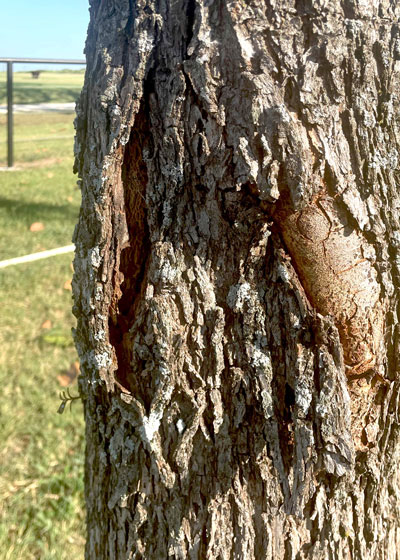
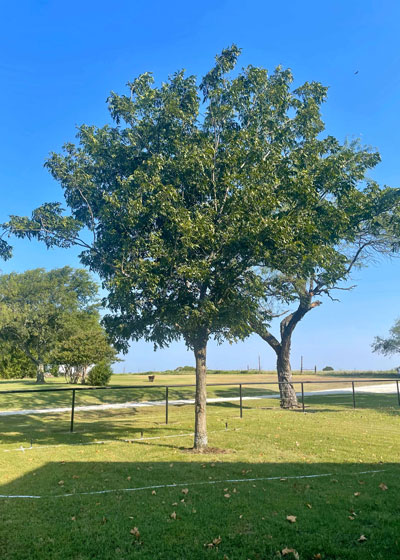
Answer: I’m judging from the tree’s overall vigor. It looks completely healthy. This may be nothing more than old bark that is sloughing off as the tree’s trunk expands in size. Bark is a dead tissue and cannot expand as the trunk grows larger. That’s a very normal happening with pecans. If there were a problem it would be affecting the top growth on that side of the canopy of the tree, which it does not seem to be doing. My vote: keep an eye on it. Leave it alone and see if the old bark doesn’t just get pushed off the trunk and out of the way as new bark forms beneath it. No call to action at this point.
QUESTION 3
WHAT CAN I DO FOR HIGH TOTAL DISSOLVED SOLIDS IN MY WELL WATER?
Question: My well water has high total dissolved solids (approximately 1500 mg/L). Is this an issue for watering grasses and shrubs? I was told it was too high and will likely kill grass/shrubs after a few years. If so, what can I do about it? Tom S., College Station.
Answer: First, I want to warn you that this is not my specialty. Soil and water science are very detailed fields of their own and I hope you will write back to the lab that ran the tests for you and ask for a complete explanation and details of your best remedies.
I do know that College Station is famous for having high levels of sodium in its water and therefore its soils. Sodium can easily accumulate in the soil to a degree that it causes serious damage to plants. Your best remedies are the leach it out of the soil by soaking the soil thoroughly so that excesses of sodium can be redissolved and carried down and away. Think of how you would leach sodium out of a potted plant’s soil by watering heavily and letting the water run out of the drain hole. Sure, the irrigation water you’re using would be adding fresh sodium, but you would be picking up all the accumulated sodium and washing it away in the process. So, that’s one way. Heavy rains help, but so does thorough watering whenever you do irrigate.
Also, when you apply gypsum to a garden soil the calcium in the gypsum actually replaces sodium on the soil particles so that they will re-dissolve and can be leached out of the soil more easily. So, while gypsum won’t actually loosen tight clay soils like products sometimes imply on their bags, it does replace sodium with harmless calcium, a very good thing.
Adding organic matter to allow better movement of water through the soil helps eliminate the sodium. Do so prior to planting for best results.
Finally, since you mentioned your lawn, bermudagrass is listed as being one of the most resistant plants that we have for high-sodium soil, so there’s your turfgrass of choice.
Again, take my answer with a grain of sodium chloride. I think I’m fairly spot-on, but I do want you to talk to the soil- and water-well-testing people at A&M.
QUESTION 4
WHAT IS HAPPENING TO MY LIVE OAK?
Question: What is happening to my live oak’s leaves? They have black spots with a yellow/orange background. Holly T, McKinney.
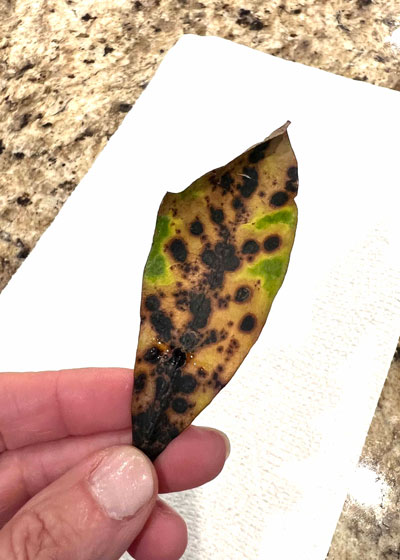
Answer: Your original photo puzzled me. I sent it on to Russell Peters, a former Texas Arborist of the Year (works for Arborilogical Services of DFW – one of the advertisers here in e-gardens). Russ has his Master’s Degree in plant pathology specializing in oak wilt. No one could offer me better help (or help for you, if you ever decide you want a company to help with your trees). Russ was puzzled, too, which is why I wrote back asking for more photos. Thanks for all of the additional ones and the extra information. Here is what Holly told us, folks:
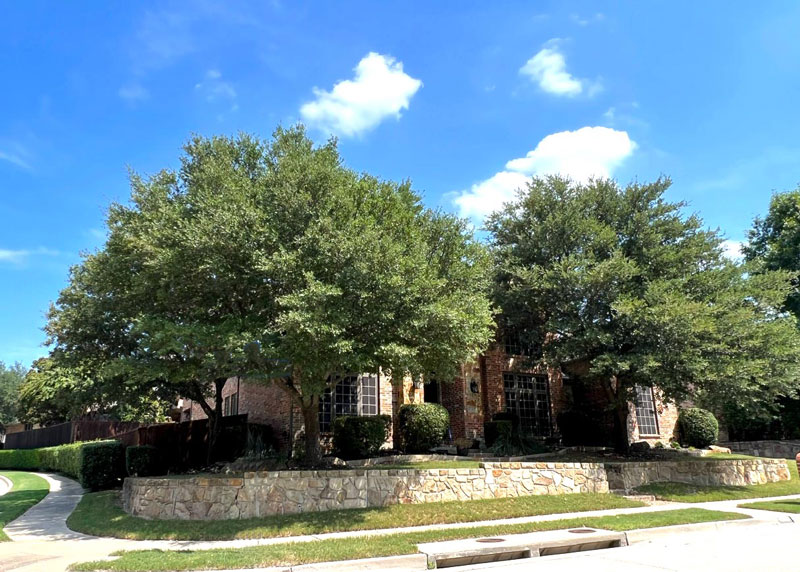
“We have 3 live oaks in our front yard. All seemed to be okay after the freezes (of the past several winters). And this is the first year I have noticed this. It is impacting practically all of this particular tree. We use a lawn care company. They have not applied anything to the trees and shrubs. The affected tree is the one on the right in the photo above. The one on the left appears to be fine. Our house is near Custer and 380 in McKinney if that helps.”
All the photos and the extra information do help. Our son and his family live within a mile or two of you, so I’m quite familiar with your soils and area.
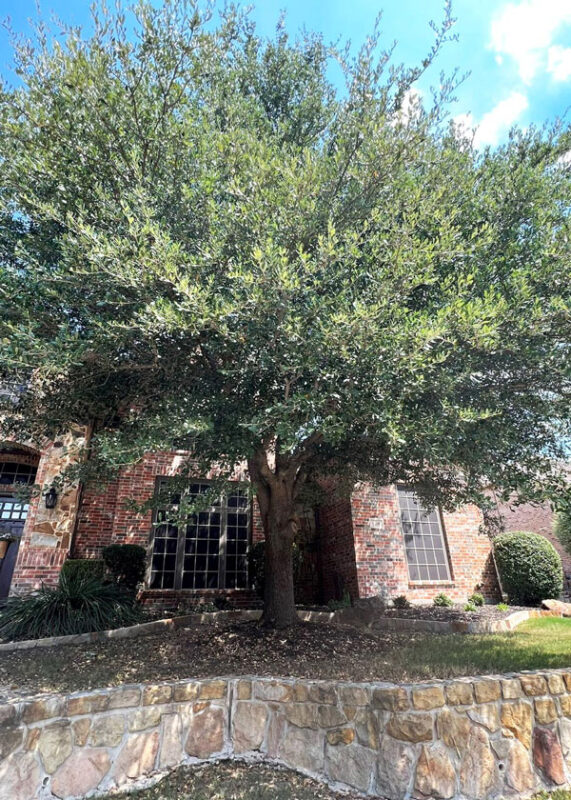
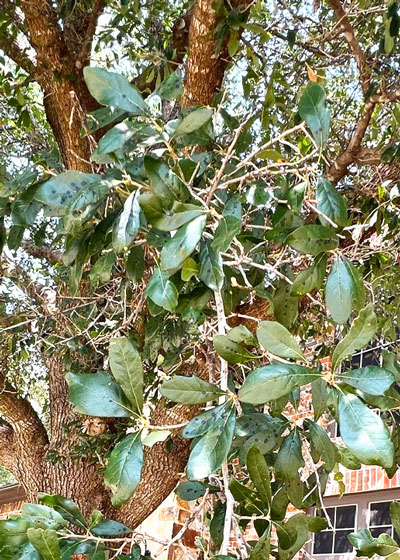
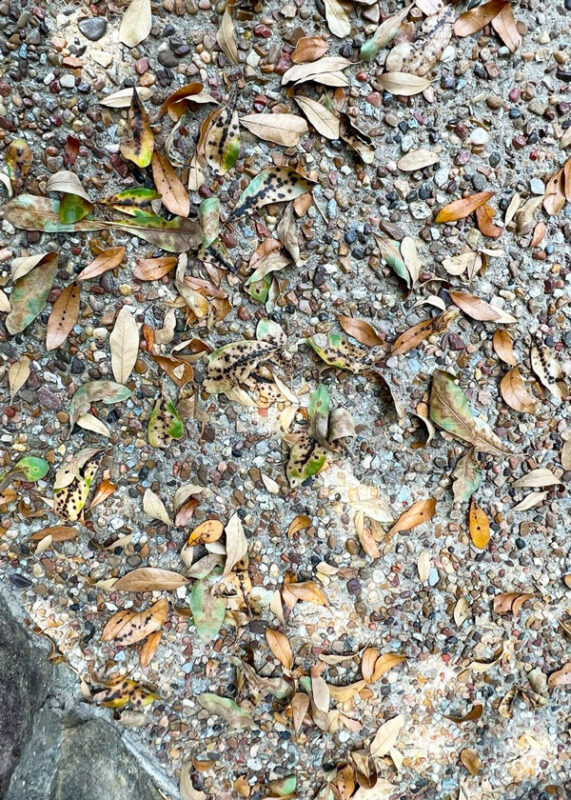
After he had a chance to examine your photos, here is what Russ sent back as his reply:
“The more I look at that one leaf, it starts to look like areas where a galling wasp tried to lay eggs, and those sites could be oviposition damage. This might be from the insect that causes the “rosy gall” – the pinkish-red small ball on the undersides of the leaves. I do not see anything that alarms me in the pictures. The amount of foliage that has been shed so far is less than most live oaks after the heat.”
I would suggest you merely keep the tree watered, Holly, and perhaps apply an all-nitrogen fertilizer to it in early September to encourage production of new leaves.
Personal thought: You might want to retain a certified arborist to keep an eye on the surface roots of your trees as they approach the retaining walls. They can become very large and very powerful. If you feel you need one, you won’t find anyone any better than the people at Arborilogical Services. We also live in McKinney, and they are the only people who will ever touch my trees. (Please forgive the blatant plug for my longtime supporters.)
QUESTION 5
WHEN CAN I PRUNE MY SPIRAEA PLANTS BACK?
Question: I would like to trim back one-third of my 40-year-old spiraeas. They have gotten leggy. Can I do that without hurting them? When should I do it? Naomi D., Arlington.
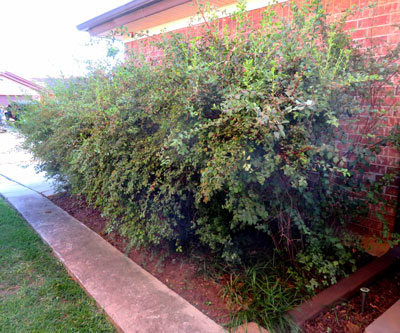
Answer: You certainly can do that. The best time for pruning spring-flowering shrubs and vines is always immediately after they finish blooming. That allows them almost a full year to regrow and form new buds for the following year’s blooms. However, in the case of spiraeas, it also means that they will start leafing out and growing, so waiting to prune them will, to a degree, penalize them. I would probably do the trimming in mid-winter even though it would mean that I’d be giving up that year’s flowers. I would do all my trimming with lopping shears and hand shears, one branch at a time. That way you can tailor them so the cuts will hardly be noticeable.
QUESTION 6
WHAT CAN I DO FOR SPROUTS BENEATH MY LIVE OAK?
Question: We have a massive live oak, perhaps 50 years old. It looks great, but baby sprouts are coming up everywhere – even 20 feet from the tree. They have taken over two flowerbeds rendering them inhospitable for anything else. Is there any cure? Andrea M., Nueces County.
Answer: This seems to be “the year” for these root sprouts. Everywhere I turn I’m getting questions on them. I just wish I had a good answer. Here is a link to this question in the FAQ pages of my website.
QUESTION 7
IS CHANGING OUR LAWN GRASS A VIABLE CONSIDERATION?
Question: What is your opinion on landscaping or changing out our grass? We have bermudagrass currently but are worried about replacing with another grass due to limited sun through our trees. We have already trimmed the trees up. The backyard faces west. Any suggestions will be appreciated. Tamara H., Murphy.
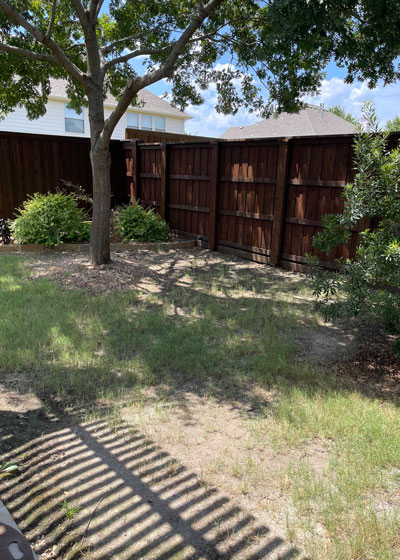
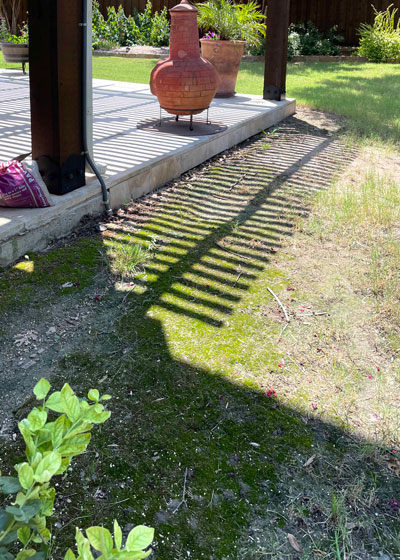
Answer: You are in that “no-man’s-land” between bermuda and St. Augustine and shade-tolerant groundcovers. I spent 15 years there with our landscape. At first we had bermuda, but as our native pecan and red oak forest grew taller the bermuda started to thin out. I switched us over to St. Augustine and it thrived for 20 years, but then it started to thin. When it became impractical, and when I vowed to remove no more lower branches and no more sun-blocking trees, I took out all the grass and changed to mondograss (monkeygrass) for a groundcover, along with purple wintercreeper euonymus, ferns, dwarf hollies, compacta nandinas, liriope and a host of other shade-tolerant plants. While we can’t play croquet on the surface, it’s every bit as pretty as the prior two iterations of our landscape have been. If you happen to have my book Lone Star Gardening, you can see multiple examples of our landscape. I took many of the photos at our house.
Postscript to my reply above: I wrote my answer before I noticed that you had attached photos to your question. You are working toward a beautiful landscape, and you also have a great deal of shade – caused both by the trees and by the fence. You are absolutely ready for shade-tolerant groundcovers and shrubs. You will enjoy the new experiences that the shade gardening will offer. I’m posting a couple of photos of our landscape to show you how it can turn out.

